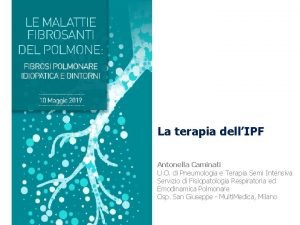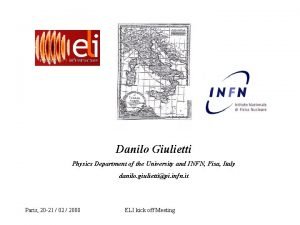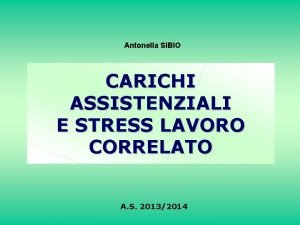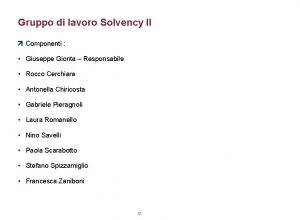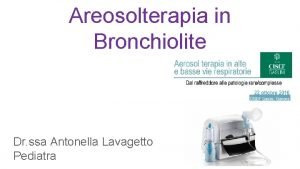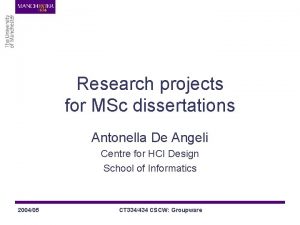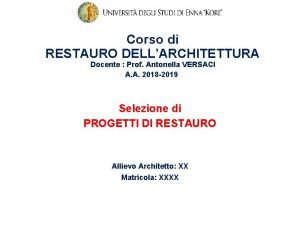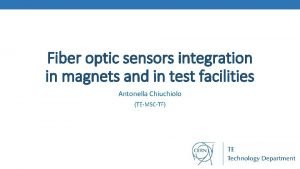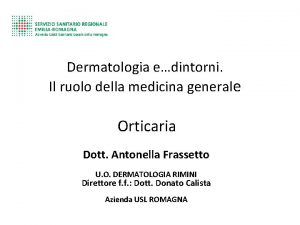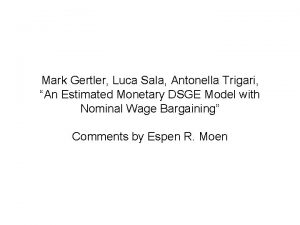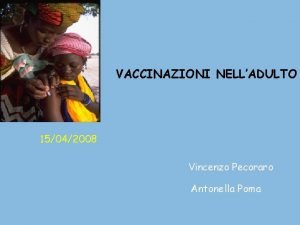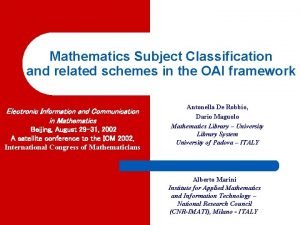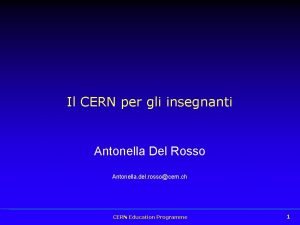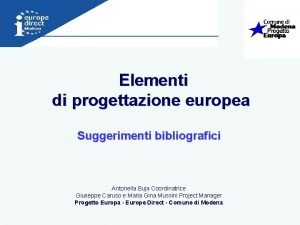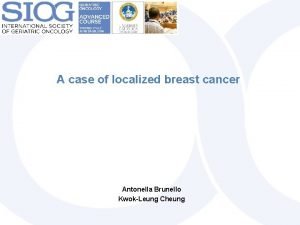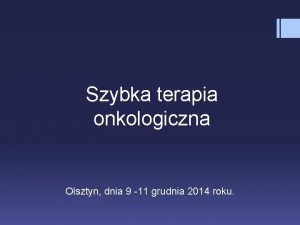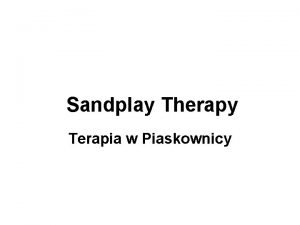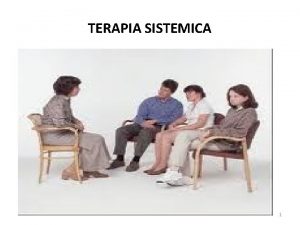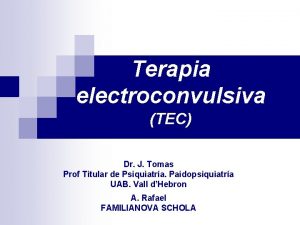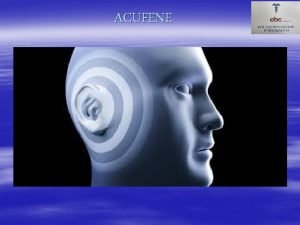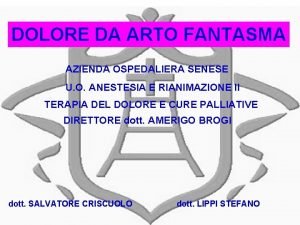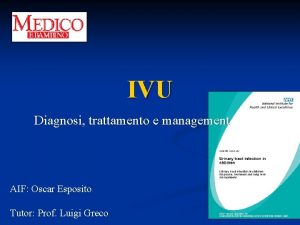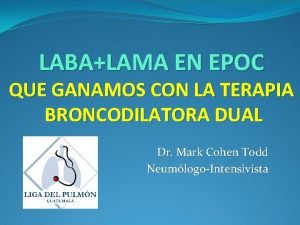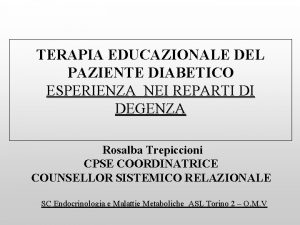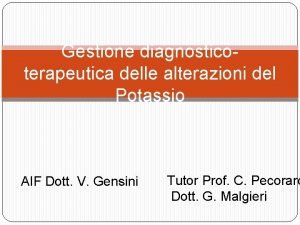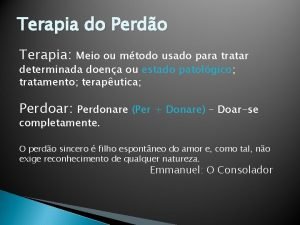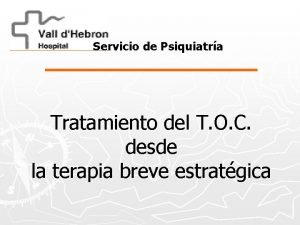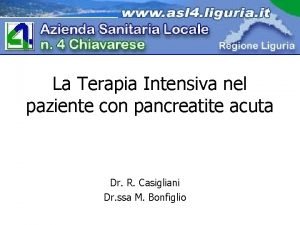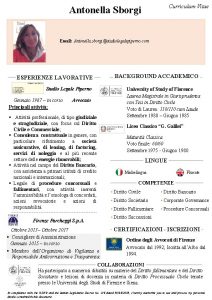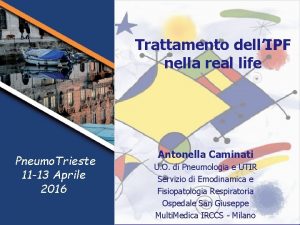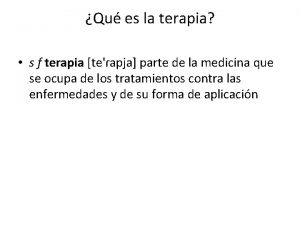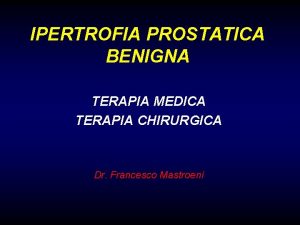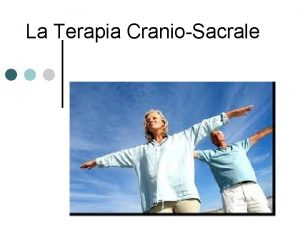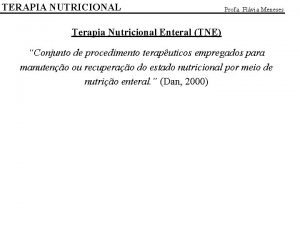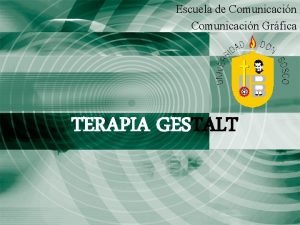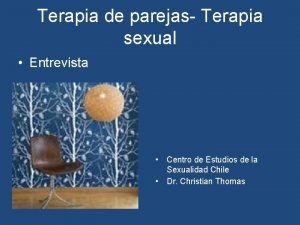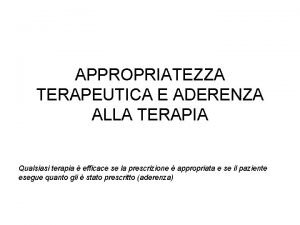La terapia dellIPF Antonella Caminati U O di




















































- Slides: 52

La terapia dell’IPF Antonella Caminati U. O. di Pneumologia e Terapia Semi Intensiva Servizio di Fisiopatologia Respiratoria ed Emodinamica Polmonare Osp. San Giuseppe - Multi. Medica, Milano

The prevalence of IPF increases with age Estimates of the mean annual standardized IPF incidence rates (for 100000 person/years) in Lombardy during 2005 -2010 by age and NCD Harari S et al. PLo. S ONE 2016; 11 (2): e 0147072. Elderly population with a smoking history Shortening of telomeres is involved

IPF survival compared with common cancers 100 60 40 as nc re g Pa Lu n us op h ag ai Oe s Br h ac om F St IP y ar Ov ye lo m a ia M ae m Le uk os ta te a Pr ph om st Ho dg kin ’s lym ea Br M el a no m a is 0 n 20 Te st 5 -year survival (%) 80 Adapted from Cancer Research UK, Cancer survival for common cancers. Accessed 3 July 2017

The clinical management of IPF is challenging. For patients with a progressive disease with unknown cure, realistic goals include - slowing the rate of disease progression - optimizing comorbidities and functional status - managing symptoms, and - preventing what is preventable KA Johannson, Thorax 2018; 73: 103 -104

Optimal clinical management of patients with IPF is multifaceted Modified from Raghu G and Richeldi L. Respir Med 2017, 129: 24 -30 Psychological support Nutritional evaluation


A phase 3 trial of pirfenidone in patients with idiopathic pulmonary fibrosis King TE et al. NEJM 2014; 370: 2083 2014 -2015: the begin of the new era of IPF Efficacy and safety of nintedanib in idiopathic pulmonary fibrosis Richeldi L et al. NEJM 2014; 370: 2071 Randomized trial of acetylcysteine in idiopathic pulmonary fibrosis NEJM 2014; 370: 2093

Where We’re Going… IPF treatment: a recent (r)evolution Anti-inflammatory Immunosuppression An Official ATS/ERS/JRS/ALAT Clinical Practice Guideline: Treatment Anti-fibrotic of IPF – An Update of 2011 Clinical Practice Immunomodulation Guideline Stem cells? Anti-oxidant Antiproliferative Statement ATS/ERS Statement NAC Colchicine Corticosteroids glutathione 2000 D-penicillamine ATS/ERS/JRS/ALAT 2011 Steroids and/or immunosuppressant No therapy approved IFN-γ 1 b Etanercept Pirfenidone Azathioprine Cyclophosphamide 1950 s 1990 s FG-3109? Pirfenidone GC-1008? Nintedanib Statins? LO Inhibitors? Combined Combo Tx? Nintedanib therapy? Imatinib Bosentan 2011 2015 Macitentan Ambrisentan Sitaxestan 2019

Currently, where is no a cure for IPF Today, we have a therapy

Lessons learned from clinical trials u Remarkable accomplishments - also in an orphan disease as IPF: several multicenter randomized clinical trials - clinical investigators, sponsors, patients join hands and work together - placebo arm/placebo controls (not more ethical) - better understanding of natural course of IPF myths clarified with facts and figures u opinions/consensus of expert opinions proven wrong by evidence u standard of care improved by sparing patients from toxic/harmful drugs u

Lessons learned from clinical trials u Almost all clinical trials: patients with mild –moderate impairment in FVC and DLCO and followed 48 -60 weeks u Patients are relatively stable during this interval u FVC decline is about 200 ml/yr in placebo group u FVC is not a predictor of hospitalization/acute exacerbation u Feasibility of enrolling patients with severe/advanced pulmonary function impairment demonstrated u Other than standard physiological/clinical assessment of disease progression, no other cellular/molecular/genetic biomarkers have been utilized

Nintedanib and Pirfenidone New antifibrotic Treatments Indicated for Idiopathic Pulmonary Fibrosis offer hopes and Raises Questions Raghu and Selman, AJRCCM, Feb 1 2015

Nintedanib and pirfenidone u Approval for treatment for IPF (FDA and EMA) “Blanket treatment” (regardless of status of disease and/or comorbid conditions) u Results of phase 3 clinical trials in a precise subgroup of patients with IPF u Decline in FVC decreases over 1 yr without symptomatic relief u Significant side effects (GI in both; rash with pirfenidone) u Tolerated by patients in the context of clinical trials

. . but real life is not a clinical trial…

Unknown effects: u u u whether the lower rate of decline in FVC in patients lasts beyond 1 yr in patients with mild –moderate impairment (PFTs) applicable to the entire spectrum of patients with IPF, especially those with severe functional impairment and/or known comorbidities Long term effects and if tolerated in patients in “real world” Is one better than the other? No head-to-head comparison if used sequential or in combination with both or with other drugs Cost effective-benefit-ratio

Some answers: u positive long term effect of both drugs u well tolerated in patients in “real world” u also in severe disease u well tolerated also in combination

When to treat

IPF is a progressive disease Early: Late: Reticular Diffuse honeycombing Midcourse: Subpleural honeycombing

Benefits of an early diagnosis • Due to the progressive nature of IPF, timely diagnosis and immediate initiation of treatment results in significant benefits for patients with IPF • Treatment of IPF aims to: – slow disease progression – improve long-term outcomes • An early diagnosis is important also for: - begin earlier evaluation for lung transplantation - exclude other more treatable diseases Ley B et al. Am J Respir Crit Care Med. 2011; 183: 431 -440 Raghu G, et al. Am J Respir Crit Care Med. 2015; 192: e 2 -e 19

Slope of decline in FVC (m. L/year) Nintedanib and pirfenidone slow disease progression in IPF Relative difference: 49. 2%; p<0. 001 Richeldi L et al. N Engl J Med 2014; 370: 2071 -82. Relative difference: 41. 5%; p<0. 001 King TE Jr et al. N Engl J Med 2014; 370: 2083 -92.

Treatment-by-time-bysubgroup interaction p=0. 5300 Kolb M et al. Thorax 2017; 72: 340– 346 Albera C et al. Eur Respir J 2016; 48: 843

Proportion of patients (%) Patients with mild IPF are least likely to receive treatment Maher et al. BMC Pulmonary Medicine (2017) 17: 124

Reasons cited by physicians for not treating patients with mild IPF Total (N=287) Physicians who monitored ≥ 50% of patients for >4 months post-diagnosis before initiating an antifibrotic (N=131) Physicians who initiated an antifibrotic within 4 months of diagnosis in the majority of patients (N=156) *p<0. 05 in z-test Maher TM, et al. Am J Respir Crit Care Med 2017; 195: A 1123

Effect of continued treatment with pirfenidone following clinically meaningful declines in forced vital capacity: analysis of data from three phase 3 trials in patients with idiopathic pulmonary fibrosis Nathan SD et al. Thorax 2016; 71: 429 Spaghetti plot of in % predicted FVC* *Randomly selected patients from the pooled placebo population from the CAPACITY and ASCEND studies (N=50)

Effect of continued treatment with pirfenidone following clinically meaningful declines in forced vital capacity: analysis of data from three phase 3 trials in patients with idiopathic pulmonary fibrosis Nathan SD et al. Thorax 2016; 71: 429 Pirfenidone (N=34) Placebo (N=68) P value 10% decline in FVC or death 2(5. 9%) 19 (27. 9%) 0. 009 No further decline in FVC 20 (58. 8%) 26 (38. 2%) 0. 059 1 (2. 9%) 14 (20. 6%) 0. 18 Death Outcome after 6 months of continued treatment following an initial decline in %predicted FVC 10%

Effect of continued treatment with pirfenidone following clinically meaningful declines in forced vital capacity: analysis of data from three phase 3 trials in patients with idiopathic pulmonary fibrosis Nathan SD et al. Thorax 2016; 71: 429 Conclusions: Longitudinal FVC data from patients with IPF showed substantial intrasubject variability, underscoring the inability to reliably assess therapeutic response using serial FVC trends. In patients who progressed during treatment, continued treatment with pirfenidone resulted in a lower risk of subsequent FVC decline or death.

Patients treated with nintedanib with absolute decline in FVC ≥ 10% predicted in the first 6 months* and their outcome in the next 6 months** Next 6 months Patients (%) Nintedanib (n=46) Placebo (n=53) * from baseline to week 24 ** between week 24 and week 52 ***Includes patients with missing FVC data at week 52 for reasons other than death. Modify from: Richeldi L et al. Presented at the European Respiratory Congress 2016 in London

How to treat

Which drug do I choose? Nintedanib Pirfenidone 50% slowing of disease progression Elevated AST/ALT, MI Elevated AST/ALT Tolerability >20% Diarrhea, nausea Nausea, rush, diarrhea, fatigue, headache Dosing Two times daily Three times daily Broader population (some possible IPF) Narrower population (excluded some IPF) ? ? Efficacy (primary endpoint comparison) Safety Patient type Patient preference FVC 50% and DLCO 30% Yrs ≤ 80; FVC 50% and DLCO 35%; 6 MWT 150 m

TEAEs leading to discontinuation in pirfenidone and nintedanib trials CAPACITY and ASCEND trials % patients TOMORROW and INPULSIS trials Pirfenidone (N=623) Placebo (N=624) Nintedanib (N=723) Placebo (N=508) Any TEAE, % 99. 0 97. 9 95. 3 89. 8 Any serious TEAE, % 27. 0 28. 5 30. 0 30. 1 Any TEAE leading to treatment discontinuation, % 14. 6 9. 6 20. 6 15. 0 Most common reasons for treatment discontinuation were: • Worsening of IPF (11. 5%) • Rash (2. 2 %) • Nausea (1. 7%) • Photosensititivity (0. 5%) AE, adverse event; TEAE, treatment-emergent adverse event Main reasons for discontinuation: • Diarrhoea (5. 3%) • Nausea (2. 4%) • Progression IPF (2. 1%) • Decreased appetite (1. 5%) While a large proportion of patients experience AEs, the rate of AEs is not a key element to adherence Lancaster L, et al. BMJ Open Respir Res 2016; 3: e 000105; Richeldi L, et al. Respir Med 2016; 113: 74– 79; Cottin V. Exp Opin Drug Safety 2017; 16: 857– 865

Pirfenidone and Nintedanib in clinical practice: tolerability and adverse drug reaction Malaise/anorexia Skin-associated adverse reaction Transaminitis Gastrointestinal-associated adverse reaction 27% Nintedanib (n=15) Pirfenidone (n=27) 19% 0% 7% 13% 7% 37% 53% 37% 100% Respirology 2017; doi: 10: 1111/resp. 13024

Symptom-centred management Pulmonary Rehabilitation Chronic respiratory disease Dyspnoea Sedentarity Deconditioning Muscle dysfunction Worsening dyspnoea Quality of life impairment Social isolation Vicious circle Young A. Ann Acad Med Singapore. 1983; 12: 410– 416

Pulmonary rehabilitation recent data Results • Exercise resulted in clinically important improvement in: – 6 MWD – Symptoms – HRQo. L • Most convincing for: – Asbestosis – IPF • To a lesser extent CTD-ILD • Successful adherence maximises the benefits CTD-ILD, connective tissue disease-ILD; HRQo. L, health-related quality of life Dowman LM, et al. Thorax. 2017; 72: 610– 619

Who to treat

IPF – the challenge

Rate of FVC decline was similar in patients with baseline FVC<50% vs ≥ 50% < 50% Mean (SD) FVC, % predicted 100 ≥ 50% Conclusions 90 80 The rate of FVC decline was similar in patients with FVC <50% vs ≥ 50% 70 60 50 40 30 0 12 36 60 84 108 132 156 180 Visit, week Number of patients: < 50% 54 47 38 30 25 21 17 15 13 ≥ 50% 530 504 469 421 381 337 299 273 233 Patients with missing baseline are excluded. Patients with prior treatment (placebo, pirfenidone 1197 mg/day and 2403 mg/day in CAPACITY 004/006 are included) Pirfenidone is an acceptable treatment in patients with more severe lung function impairment Costabel U et al. Presented at ERS 2016

Annual rate of decline in FVC over 96 weeks in subgroups by patient characteristics at start of INPULSIS®-ON Kreuter et al. Presented at American Thoracic Society (ATS) International Conference, Washington, DC, USA, 19– 24 May 2017

Eligibility criteria based on HRCT • To qualify to enter the INPULSIS® trials in the absence of a surgical lung biopsy, criteria A and B and C; or A and C; or B and C had to be met: A B C Definite honeycomb lung destruction with basal and peripheral predominance Presence of reticular abnormality and traction bronchiectasis consistent with fibrosis with basal and peripheral predominance Atypical features are absent, specifically nodules and consolidation. Ground glass opacity, if present, is less extensive than reticular opacity pattern • HRCT scans were assessed centrally by one expert radiologist

Eligibility criteria based on HRCT • To qualify to enter the INPULSIS® trials, in the absence of a surgical lung biopsy, criteria A and B and C; or A and C; or B and C had to be met: A B C Definite honeycomb lung destruction with basal and peripheral predominance Presence of reticular abnormality and traction bronchiectasis consistent with fibrosis with basal and peripheral predominance Atypical features are absent, specifically nodules and consolidation. Ground glass opacity, if present, is less extensive than reticular opacity pattern • HRCT scans were assessed centrally by one expert radiologist

Eligibility criteria based on HRCT • To qualify to enter the INPULSIS® trials, in the absence of a surgical lung biopsy, criteria A and B and C; or A and C; or B and C had to be met: A B C Definite honeycomb lung destruction with basal and peripheral predominance Presence of reticular abnormality and traction bronchiectasis consistent with fibrosis with basal and peripheral predominance Atypical features are absent, specifically nodules and consolidation. Ground glass opacity, if present, is less extensive than reticular opacity pattern • HRCT scans were assessed centrally by one expert radiologist

Aim and methods • Aim – To investigate the potential impact of HRCT diagnostic subgroups on the effect of nintedanib in patients with IPF • Methods – Post-hoc subgroup analyses were conducted using pooled data from the two INPULSIS® trials in patients with: Honeycombing on HRCT and/or confirmation of UIP pattern by surgical lung biopsy versus Features of possible UIP pattern* on HRCT and no surgical lung biopsy – Analyses were conducted on the primary and key secondary endpoints *And traction bronchiectasis. Possible UIP comprises all three of the following features: subpleural, basal predominance; reticular abnormality; absence of features noted as inconsistent with UIP pattern [Raghu et al. Am J Respir Crit Care Med 2011; 183: 788– 824].

Annual rate of decline in FVC Honeycombing on HRCT and/or confirmation of UIP pattern by surgical lung biopsy Adjusted annual rate (SE) of decline in FVC (m. L/year) n=425 n=213 n=298 ∆117. 0 m. L (95% CI: 76. 3, 157. 8) *And traction bronchiectasis. Features of possible UIP pattern* on HRCT and no surgical lung biopsy ∆98. 9 m. L (95% CI: 36. 4, 161. 5) Treatment-by-time-bysubgroup interaction p=0. 8139 Nintedanib Placebo n=125

Aim and methods - Aim • To investigate the potential impact of emphysema on the effect of nintedanib in patients with IPF - Methods • Presence of emphysema (yes/no) at baseline was determined by qualitative assessment of chest HRCT scans, centrally reviewed by a single radiologist • Post-hoc subgroup analyses of patients with/without emphysema at baseline were conducted using pooled data from the two INPULSIS™ trials • Subgroup analyses were conducted on the primary and key secondary endpoints

Annual rate of decline in FVC No emphysema at baseline Adjusted annual rate (SE) of decline in FVC (m. L/year) n=384 ∆115. 4 m. L (95% CI: 73. 8, 157. 1) Emphysema at baseline n=254 n=257 ∆102. 0 m. L (95% CI: 43. 2, 160. 9) Treatment by time by subgroup interaction p=0. 5199 Nintedanib 150 mg bid Placebo n=166

Addressing ongoing challenges in pulmonary fibrosis in the era of antifibrotic treatment Confident diagnostic criteria Disease progression When to initiate treatment Treatment of patients with advanced disease Combination treatment Precision medicine Feasibility of drug development in rare diseases Other chronic fibrosing ILD

The initial differential diagnosis of ILD is difficult u Overlapping clinical presentations occur among all ILD diagnoses u No single chest imaging or pathologic pattern is unique to a specific diagnosis (e. g. , a UIP chest imaging or pathologic pattern can be seen in IIP, CTD, HP and other exposure-related ILD) u Significant discordance between clinical, chest imaging, and pathologic features often occurs (i. e. , classic combination patterns are not universal)

Another perspective: classification according to disease behaviour Clinical behaviour Treatment goal Monitoring strategy Remove possible cause Short-term (3 - to 6 - month) observation to confirm disease regression Reversible disease with risk of progression (e. g. cellular NSIP and some fibrotic NSIP, DIP, COP) Initially achieve response and then rationalise longer term therapy Short-term observation to confirm treatment response. Long-term observation to ensure that gains are preserved Stable with residual disease (e. g. some fibrotic NSIP) Maintain status Long-term observation to assess disease course Progressive, irreversible disease with potential for stabilisation (e. g. some fibrotic NSIP) Stabilise Long-term observation to assess disease course Slow progression Long-term observation to assess disease course and need for transplant or effective palliation Reversible and self-limited (e. g. many cases of RB-ILD) Progressive, irreversible disease despite therapy (e. g. IPF, some fibrotic NSIP) COP, cryptogenic organising pneumonia; DIP, desquamative interstitial pneumonia; RB-ILD, respiratory bronchiolitis-interstitial pneumonia. Travis WD et al. Am J Respir Crit Care Med 2013; 188: 733 -48.

Progressive fibrosing ILD (PF-ILD) Several patients with ILD develop a progressive fibrosing phenotype, characterised by self-sustaining fibrosis, deterioration in lung function, and worsening of symptoms and quality of life Is there a distinct phenotype of patients with PF-ILD who might benefit from antifibrotic treatment similar to IPF?

Ongoing research in other fibrosing ILDs Drug/patient population Clinicaltrials. gov Study design; sample size Primary endpoint SSc-ILD (SENSCIS™) NCT 02597933 Randomised, placebo-controlled; n=520 Rate of decline in FVC over 52 weeks PF-ILD NCT 02999178 Randomised, placebo-controlled; n=600 Rate of decline in FVC over 52 weeks Chronic HP NCT 02496182 Randomised, placebo-controlled; n=60 Change in FVC at week 52 Progressive ILD associated with clinically amyopathic dermatomyositis NCT 02821689 Open-label, randomised, placebocontrolled; n=57 Survival 12 months from onset of ILD LTx recipients with BOS grade 1 -2 NCT 02262299 Randomised, placebo-controlled; n=80 Change in FEV 1 at month 6 Fibrotic HP NCT 02958917 Randomised, placebo-controlled; n=40 Change in FVC at week 52 Unclassifiable PF-ILD NCT 03099187 Randomised, placebo-controlled; n=250 Rate of decline in FVC over 24 weeks RA-ILD NCT 02808871 Randomised, placebo-controlled; n=270 PFS at week 52 (progression defined as FVC decline ≥ 10% predicted) SSc-ILD (SLS III) - on top of MMF NCT 03221257 Randomised, placebo-controlled; n=150 Change in FVC %pred at 18 months Nintedanib Pirfenidone

Conclusions u IPF is a devastating and life-shortening disease u Symptomatic IPF inevitably progresses u Rate of progression is the same at all levels of disease severity u Nintedanib and pirfenidone slow disease progression u Earlier treatment should magnify benefits of slowing disease u Quality of life gain should accrue the longer patients live u There is an urgent unmet clinical need for effective therapies for ILD with a progressive fibrotic phenotype other than IPF

Multidisciplinary approach to treatment of IPF u Pulmonologist u Respiratory therapist/ Physiotherapist u Nutritionist u Palliative care specialist u . . .

Grazie per l’attenzione
 Antonella caminati
Antonella caminati Danilo giulietti
Danilo giulietti Antonella d'arminio monforte
Antonella d'arminio monforte Antonella anghinoni
Antonella anghinoni Ostetricia forense
Ostetricia forense Leggi fascistissime treccani
Leggi fascistissime treccani Ambrosone antonella dirigente
Ambrosone antonella dirigente Antonella vacca
Antonella vacca Antonella sangalli
Antonella sangalli Antonella sibio
Antonella sibio Training structure template
Training structure template Antonella maccarone
Antonella maccarone Ponte disolfuro legame covalente
Ponte disolfuro legame covalente Antonella de santo
Antonella de santo Giuseppe gionta
Giuseppe gionta Lavagetto pediatra
Lavagetto pediatra Antonella de angeli
Antonella de angeli Antonella damiotti
Antonella damiotti Antonella versaci
Antonella versaci Antonella chiuchiolo
Antonella chiuchiolo Orticaria dermografica forum
Orticaria dermografica forum Antonella trigari
Antonella trigari Antonella filastro
Antonella filastro Antonella poma
Antonella poma Antonella de robbio
Antonella de robbio Antonella del rosso cern
Antonella del rosso cern Antonella buja
Antonella buja Antonella pesce
Antonella pesce Antonella scardino
Antonella scardino Antonella brunello
Antonella brunello Terapia gestalt 9 zaleceń
Terapia gestalt 9 zaleceń Gene therapy in sports
Gene therapy in sports Ciclo vital geyman
Ciclo vital geyman Iridodialisi
Iridodialisi Terapia electroconvulsiva
Terapia electroconvulsiva Modelo de terapia de strong como influencia interpersonal
Modelo de terapia de strong como influencia interpersonal Flunarizina acufeni
Flunarizina acufeni Arto fantasma terapia
Arto fantasma terapia Terapia antibiotica
Terapia antibiotica Laba lama epoc
Laba lama epoc Funciones de la terapia dialéctico conductual
Funciones de la terapia dialéctico conductual Modelo sistemico y ecologico
Modelo sistemico y ecologico Terapia educazionale del diabetico
Terapia educazionale del diabetico Epistemologia de la terapia cognitivo conductual
Epistemologia de la terapia cognitivo conductual Terapia racional emotiva de beck
Terapia racional emotiva de beck Iperkaliemia ecg
Iperkaliemia ecg Ectima contagioso terapia
Ectima contagioso terapia Frases de auto perdão
Frases de auto perdão Slide terapia do amor
Slide terapia do amor Quien fue rogers
Quien fue rogers Sistema perceptivo reactivo
Sistema perceptivo reactivo Iniezione intratecale
Iniezione intratecale Addensamento parenchimale polmonare
Addensamento parenchimale polmonare
